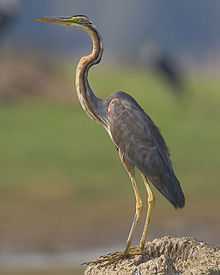Purple Heron
| Purple Heron | |
|---|---|
 | |
| Adult from Nagarhole National Park | |
| Conservation status | |
| Scientific classification | |
| Kingdom: | Animalia |
| Phylum: | Chordata |
| Class: | Aves |
| Order: | Pelecaniformes |
| Family: | Ardeidae |
| Genus: | Ardea |
| Species: | A. purpurea |
| Binomial name | |
| Ardea purpurea (Linnaeus, 1766) | |
The Purple Heron (Ardea purpurea) is a wading bird in the heron family Ardeidae, breeding in Africa, central and southern Europe, and southern and eastern Asia. The European populations are migratory, wintering in tropical Africa; the more northerly Asian populations also migrate further south within Asia. It is a rare but regular wanderer north of its breeding range.
Description
The Purple Heron is a large bird, 78–97 cm (31–38 in) in length with a standing height from to 70 to 94 cm (28 to 37 in) and a 120–152 cm (47–60 in) wingspan.[2][3] However, it is slender for its size, weighing only 0.5–1.35 kg (1.1–3.0 lb).[4] It is somewhat smaller than the Grey Heron, from which it can be distinguished by its darker reddish-brown plumage, and, in adults, darker grey back. It has a narrower yellow bill, which is brighter in breeding adults. The most similarly-colored heron is the Goliath Heron, which is considerably larger.
Taxonomy
There are three or four subspecies:
- Ardea purpurea purpurea Linnaeus, 1766. Africa, Europe north to the Netherlands, and southwestern Asia east to Kazakhstan.
- Ardea purpurea bournei (de Naurois, 1966), Bourne's Heron. Cape Verde Islands (included in purpurea by some authors, but treated as a distinct species Ardea bournei by some others).
- Ardea purpurea madagascariensis Oort, 1910. Madagascar.
- Ardea purpurea manilensis Meyen, 1834. Asia from Pakistan east to the Philippines and Indonesia, and north to Primorsky Krai, Russia.
Behaviour
The Purple Heron breeds in colonies in reed beds or trees close to large lakes or other extensive wetlands. It builds a bulky stick nest.
It feeds in shallow water, spearing fish, frogs, insects and small mammals. It will often wait motionless for prey, or slowly stalk its victim. It tends to keep within reedbeds more than the Grey Heron, and is often inconspicuous, despite its size.
It has a slow flight, with its neck retracted. This is characteristic of herons and bitterns, and distinguishes them from storks, cranes and spoonbills, which extend their necks. The long neck of Purple Heron looks particularly snake-like, with more of an S-shape in flight. The call is a loud croaking "krek".
The Purple Heron is one of the species to which the Agreement on the Conservation of African-Eurasian Migratory Waterbirds (AEWA) applies.
Gallery

-
Subspecies manilensis in North Sulawesi, Indonesia
-

An adult Purple Heron with chicks on a nest at Lake Baringo, Great Rift Valley, Kenya
-

In flight at Laguna di Venezia, Italy
-
_in_Kolleru%2C_AP_W3_IMG_4052.jpg)
A. p. manilensis in Kolleru Lake, Andhra Pradesh, India
-

Couple of Purple Herons in nuptial attire at the nest with nestlings. Manych River, Russia
-

ID composite
References
- ↑ BirdLife International (2012). "Ardea purpurea". IUCN Red List of Threatened Species. Version 2013.2. International Union for Conservation of Nature. Retrieved 26 November 2013.
- ↑ "Purple heron videos, photos and facts - Ardea purpurea". ARKive. Retrieved 2011-10-18.
- ↑ Sálim Ali (1996). The Book of Indian Birds. Bombay: Bombay Natural History Society. ISBN 978-0195637311.
- ↑ John B. Dunning Jr. (Editor) (1992). CRC Handbook of Avian Body Masses. CRC Press. ISBN 978-0-8493-4258-5.
- Handbook of the Birds of the World 1: 407. Lynx Edicions.
- Ornitaxa: Ardea bournei split as a separate species
External links
| Wikimedia Commons has media related to Ardea purpurea. |
- Ageing and sexing (PDF) by Javier Blasco-Zumeta & Gerd-Michael Heinze
- Purple Heron - Species text in The Atlas of Southern African Birds
- Avibase



